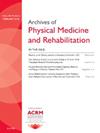用数据驱动的跨学科模型推进医院获得性压力伤害预防
IF 3.6
2区 医学
Q1 REHABILITATION
Archives of physical medicine and rehabilitation
Pub Date : 2025-05-01
DOI:10.1016/j.apmr.2025.03.025
引用次数: 0
摘要
我们的项目旨在通过将风险识别研究转化为有效的质量改进策略来减少HAPI在脊髓损伤患者中的发生率。目的开发和实施“压力伤害预防工具包”,通过HAPI报告仪表板进行增强,以改进基于风险的临床决策并明确医疗保健提供者的角色。方法采用为期18个月的PDSA(计划、实施、研究、行动)周期,引入新的护理工作流程来识别高危患者,采用HAPI指标的实时数据可视化,并定期召开跨学科会议来完善患者护理计划和干预措施。结果:最初的PDSA周期强调了协议改进的领域,例如增加楼层经理的支持,创建可持续的、适应性强的工作流程。未来的周期将集中于改善仪表盘的参与、预防合规和跨学科讨论的保真度。该方法集成了数字工具和跨学科见解,以改进传统的HAPI预防策略,为在整个医院更广泛地实施铺平了道路。结论:我们的项目展示了技术增强的跨学科策略在提高患者护理质量和降低HAPI率方面的变革潜力。本文章由计算机程序翻译,如有差异,请以英文原文为准。
Advancing Hospital Acquired Pressure Injury Prevention with a Data-Driven Transdisciplinary Model
Introduction
Our project aims to reduce HAPI occurrences in spinal cord injury patients by translating risk identification research into effective quality improvement strategies.
Objective
To develop and implement a "Pressure Injury Prevention Toolkit," enhanced by a HAPI reporting dashboard, to improve risk-based clinical decision-making and define clear roles for healthcare providers.
Methods
Using an 18-month Plan, Do, Study, Act (PDSA) cycle, we introduced new nursing workflows for identifying high-risk patients, real-time data visualization for HAPI metrics, and regular transdisciplinary meetings to refine patient care plans and interventions.
Results
The initial PDSA cycle highlighted areas for protocol refinement, such as increasing buy-in from floor managers and creating sustainable, adaptable work processes. Future cycles will focus on improving dashboard engagement, prevention compliance, and transdisciplinary discussion fidelity.
Implications
This approach integrates digital tools and transdisciplinary insights to revamp traditional HAPI prevention strategies, paving the way for broader implementation across the hospital.
Conclusion
Our project demonstrates the transformative potential of technology-enhanced, transdisciplinary strategies in improving patient care quality and reducing HAPI rates.
求助全文
通过发布文献求助,成功后即可免费获取论文全文。
去求助
来源期刊
CiteScore
6.20
自引率
4.70%
发文量
495
审稿时长
38 days
期刊介绍:
The Archives of Physical Medicine and Rehabilitation publishes original, peer-reviewed research and clinical reports on important trends and developments in physical medicine and rehabilitation and related fields. This international journal brings researchers and clinicians authoritative information on the therapeutic utilization of physical, behavioral and pharmaceutical agents in providing comprehensive care for individuals with chronic illness and disabilities.
Archives began publication in 1920, publishes monthly, and is the official journal of the American Congress of Rehabilitation Medicine. Its papers are cited more often than any other rehabilitation journal.

 求助内容:
求助内容: 应助结果提醒方式:
应助结果提醒方式:


